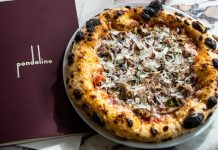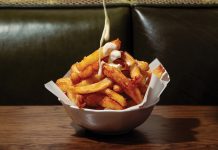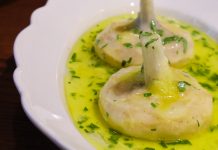
In the last two years, restaurateur Ford Fry—who opened JCT Kitchen & Bar in 2007—has tripled his footprint, opening No. 246 in Decatur and the Optimist on the Westside. This year he’s at it again, with King and Duke set to open in Buckhead in March and a yet-to-be-named restaurant opening in the former Bluepointe space in the fall. (For more on the chef, check out Candice Dyer’s profile, “Have You Dined At Ford’s Lately?”) Rumor has it Fry has his heart set on an Austin-style Tex-Mex restaurant, too, and has been eying both Alpharetta and Krog Street for the location. Says Fry, “Nothing’s signed yet.” Yet being the operative word.
How’s King and Duke coming along?
We’re in the middle of construction so it’s not the prettiest thing right now. We’re building the firebrick for the twenty-four-foot-long hearth.
What will the space look like?
Before, there were a lot of curves and lot of levels. These are going away. When you walk in, there will be a hostess stand and lounge area. You’ll look down a long shotgun. On the left wall is the long straight bar, which continues all the way to the kitchen. Behind the hearth, there’s a second level for a private dining room and a seating area. There will be three different distinct areas with three different styles of lighting. I love banquettes. At one point, it was like men’s suit material like pinstripes with different fabrics in the three seating areas. There will be metal boxes backlit along the wall. There will be wood-paneled walls, and the ceiling will be lined with light woods as well.
It’s going to be warmer than some of our other restaurants. We’ll have floor lamps in one room, hanging lighting in another—industrial lights made by a guy in Brookwood. The private dining room is called the Drawing Room. It seats fourteen to sixteen with a concealed door, lined leather walls, an antiqued mirrored ceiling so you’re stepping back in time in a way. Outside, we’ll have three awnings, all-new outdoor banquettes with global hanging lighting so the whole corner just glows. It’ll seat seventy-five plus the secondary bar.
What are some menu items?
So far, we’ve just decided on the philosophy. We’ll have hooks hanging above the fire for whole ducks with a skillet of potatoes or plums to absorb the drippings underneath. It’s an old-world way of cooking—making everything together as opposed to being really compartmentalized. All the main course stuff will come directly from the wood-burning hearth. No burners, no sauté pans. In a way, we’re limited to that.
Two defined menu items are: the King, a 1-kilogram bone-in rib eye, slow-roasted with marrow bones and salad that serves two; and the Duke, a custom-ground burger with dry-aged meat on a brioche bun.
Is it a coincidence that you’ve selected two spaces formerly home to Buckhead Life Restaurants for your new concepts? Why do you think yours will succeed where theirs didn’t?
Originally we were looking at one or the other. We chose the Nava space, and then the Pinnacle building owners came back to us [with another offer]. The timing just made sense. Buckhead Life did well with those spaces. Nava was cranking when I first moved to town. Ever since Kevin Rathbun left, Nava stopped moving forward. They didn’t update it. Southwestern cuisine died a long time ago. Buckhead Life could’ve rebranded it, but instead it seems like they just ran out the lease.
I’m really against trying to turn a restaurant into a club-type feel. Bluepointe was doing that at the bar at night. When the economy took a digger, they fell off [the radar]. They had never grasped the local clientele—just business travel. I want my restaurant to be approachable and reasonable for the locals. Business people are welcome but it’s got to be more for the people of Atlanta.
Everyone says I’m making a “Buckhead restaurant,” but it may be less expensive and more edgy than Buckhead is used to. We’re making our own restaurant and just happen to be putting it in Buckhead.
Let’s talk about the restaurant you’re putting in the Bluepointe space. What exactly is the concept?
We’re going to have a hearth—just a little spot at Bluepointe, one-fifth of the size of what King and Duke has—in the kitchen. We’ll cook whole fish in the wood-burning hearth. I think it’d be fun to add another seafood-centric restaurant. The Optimist covers Louisiana to Maine—it’s American in style. For the Bluepointe space, I want to pull from Spain, France, and Italy. We’ll do simple seafood dishes using olive oil and citrus, plus the crudo bar.
Any names in the works?
The naming is the hardest part of doing a restaurant. It’s like naming a kid. You can find something negative in everything. This restaurant’s name may end up being something that means absolutely nothing.
What will the decor be like?
I’m really excited about this one. Currently it’s really modern in look—a lot of false levels. I’m going to try to straighten the curves and go more classic. I’m removing the carpet and laying herringbone wood flooring. We’ll have old school tile in the entryway. We’ll have light fixtures similar to those in the Optimist but more industrial, hanging from strands from the ceiling. The bar will be classic European style and even longer than the Optimist. There will be little foxes, stuffed animals, (taxidermy) in the design. The crudo bar will be visible from the entrance. I want to open it up into a patio on the street with a ton of landscaping—trees, plants, and herbs to soften it up. There will be awnings or umbrellas or trellis with fabric to shade the patio.
Who will lead the kitchen?
I have some ideas but I’m not sure . . . it’s between two people who are currently with me right now. It’s not Kevin Maxey—he’s going to be a project guy with us. He’s good at the organizational structure and planning.
Okay, now about that food truck you’re working on: What inspired you to create one?
I never wanted to do one for a business but I thought it’d be fun to have one within our company and take turns manning it and feeding the inner city. We’ve supported City of Refuge for years. I can get the food truck off the ground and let City of Refuge take it from there. I have too much going on to handle it all myself.
City of Refuge trains these single moms who are homeless. They put them up for a year and train them to cook. The food truck would act as a training vehicle. It would be self-sustaining. It’d go to food truck parks to sell to everyday customers and the revenue from that goes toward food to feed the homeless.
What kind of food will it serve?
I love the heritage of the Mississippi Delta and the hot tamales that come from there. We’re planning to do a couple types of hot tamales and certain tacos from that region. We’ll have a wood-burning grill on the truck and make marinated meats and Po’ boys.






















![The North Carolina Museum of Natural Sciences’ newest exhibit is a [pre]historic first](https://cdn2.atlantamagazine.com/wp-content/uploads/sites/4/2024/04/DD-3-100x70.jpg)



